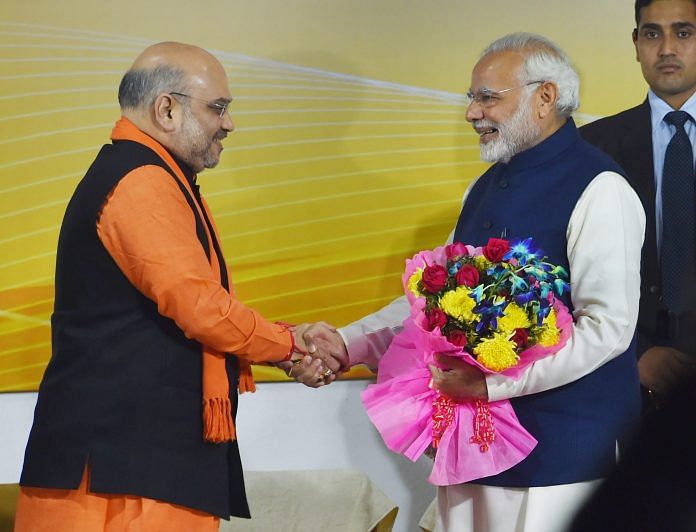On the campaign trail, the Congress capitalised on many of the BJP’s shortcomings, but it had no counter for Prime Minister Narendra Modi himself.
New Delhi: Crossing the halfway mark, the BJP is all set for its sixth straight term in Gujarat, even though the Congress has improved its tally significantly since 2012.
As the hysteria surrounding the assembly elections settles down a little, the results give useful insights into how the various narratives played out, and why the BJP still won.
Given 22 years of anti-incumbency in the state and nearly four years at the Centre, the BJP had enough weak spots – the Patidar agitation, farmer discontent, as well as anger over GST and demonetisation. What it had in its favour was its record of development in the state, its solid urban base, and most importantly, Prime Minister Narendra Modi’s massive popularity.
The Congress picked on the BJP’s vulnerabilities, raking up these issues frequently while stitching together an interesting caste coalition to strengthen itself.
Region-wise trends
The Patidar agitation has clearly cost the BJP, given its lower numbers in Saurashtra, where this factor, along with farmer anger, seems to have hit the party hard.
In Morbi – the ceramic hub of Gujarat, which was hit by demonetisation and GST and which also has a sizeable Patidar population – ThePrint had found that anger against the government’s economic policies had dissipated, but the Patidar rebellion was a huge factor. The latter clearly seems to have outweighed the former, with the BJP losing all three seats in Morbi district.
In Rajkot, on the other hand, the BJP’s loyal urban vote base seems to have offset Patidar anger, with the party winning six of the eight seats. In Rajkot, ThePrint had found substantial support for the BJP, especially among the youth and first-time voters, barring some young voters from the Patel community.
In Junagadh, cotton farmers, though fairly upset about inadequate prices for their produce, seemed to back BJP. Across other parts, however, farmers seemed restless, wanting a change. It is evident that rural Saurashtra did express its unhappiness with the BJP by backing the Congress through its votes.
The urban vote was key to the BJP, and Ahmedabad and Surat delivered big numbers for it. When ThePrint visited 11 of the 21 constituencies of Ahmedabad, it found huge support for the BJP and Modi, with voters talking about ‘vikas’ in a big way. While in 2012, the BJP had won 17 of the 21 seats there, this time, it has won 16.
In Surat, meanwhile, ThePrint had found anger persisting over the adverse impact of the BJP’s policies on businesses, but most traders had unequivocally said they would back the BJP since they didn’t think there was any credible alternative. The party won 15 of the 16 seats in Surat.
In Amreli, a cooperatives hub, women voters – Modi’s most solid backers – seemed surprisingly divided about the BJP. Clearly, the disillusionment translated into electoral losses for the BJP, as it lost all five seats in the district.
In north Gujarat, a vulnerable region for the BJP, the party was hoping to cash in on its flood relief work in the worst-affected areas. In Banaskantha, ThePrint found mixed responses to the party in the worst-hit villages, including in state minister Shankar Chaudhary’s constituency Vav. Chaudhary lost the election with a margin of about 6,000 votes. The BJP held three of the nine seats in Banaskantha, and the tally has remained the same in this election.
The BJP’s strategy of giving tickets to rebel Congress MLAs had mixed results. In Jamnagar, where there were two such MLAs, ThePrint found them to be popular, irrespective of the party. While the rebel MLA from Jamnagar North won his seat, the one from Jamnagar Rural lost to his Congress counterpart.
ThePrint, in its travels, also found the BJP making significant inroads into the tribal community. In Dangs, which has been a traditional Congress bastion, Modi’s ‘vikas’ was a popular refrain. The BJP lost that seat by a narrow margin of just 700 votes. Even in tribal-dominated constituencies like Kalol and Halol in Panchmahal, ThePrint found significant support for the BJP, with tribal communities praising the government for bringing good roads and pucca houses to them. The BJP won both these seats.
No counter for Modi
On the one hand, as it ducked anger over GST and demonetisation, limited the impact of the Patidar agitation to certain geographies/demographies, managed to make gains among tribal communities, retained its urban vote bank and milk its ‘vikas’ model to some extent, the BJP failed to address farmer anger, make gains in rural Gujarat or completely minimise Patidar angst by engineering counter caste consolidation.
While these parallel, yet often intertwined, narratives, which played out in different forms on the ground, influenced the election to deliver the BJP a slim win, what was consistent across the state was immense goodwill for PM Modi.
It would be safe to say, therefore, that Modi was BJP’s greatest trump card, for which the Congress had no real counter.



